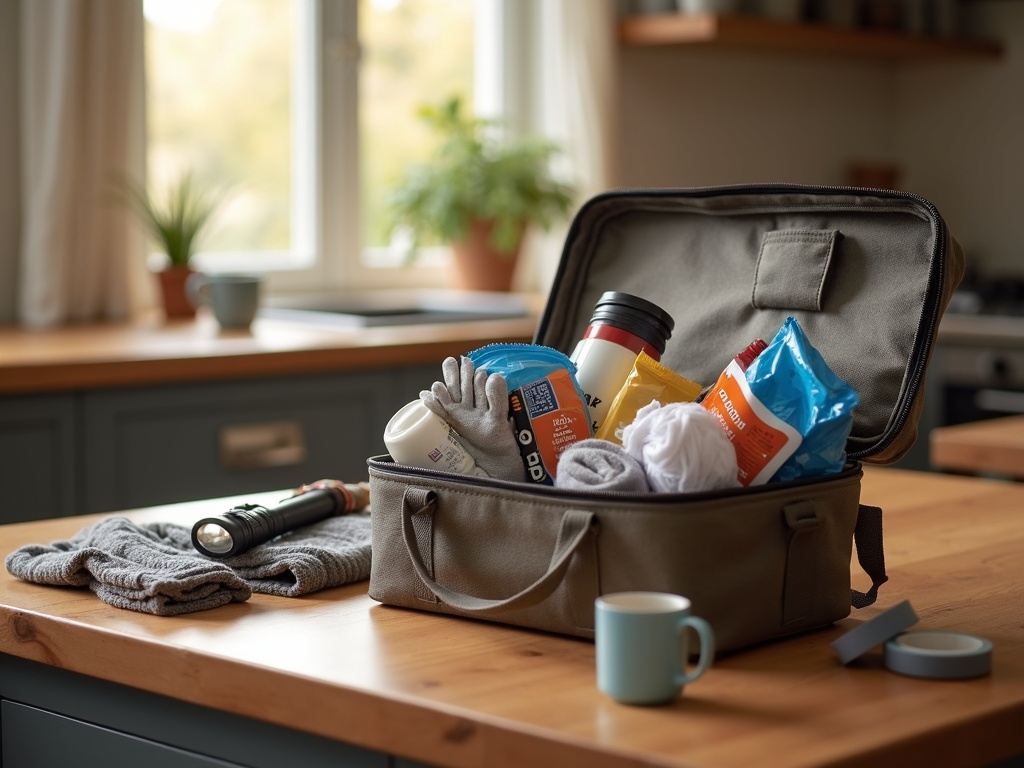Family Ready Kit: Easy Plans for Messy Days

Rainy nights, power cuts, and tiny kitchen scares happen. No one enjoys them, but they feel easier when there is a plan. Think of this as a calm checklist you can remember, the kind that makes the house feel safe even when the weather gets loud.
What a “ready kit” actually means
A ready kit is a small box that helps the family handle messy moments. It does not need fancy gear. A torch, spare batteries, a phone charger, gloves, big rubbish bags, tape, wet wipes, a marker, and a small first aid kit cover most needs. Add spare socks for each person. Dry feet keep everyone steady. Put the box where hands can reach it fast. Check the batteries every few months so they still work when the lights go out.
Pick a safe spot in the house
Choose one room to use as the base during storms. A hallway with no big windows is great for strong wind. A living room away from tall trees can work for heavy rain. Keep a clear path to the front door. Move low items off the floor if water might creep in. Pick a backup spot in case the first room gets wet. Talk through where pets will rest and where young kids can sit with a book while adults sort things out.
Contacts you can grab fast
When trouble starts, dialling the right person quickly saves time. Add family, a trusted neighbour, the power company, and a local repair contact. If water starts getting in, search for Flood Emergency Services before you begin clean up, then keep it simple: turn off the water, stay safe around power, and get airflow going. Also note where the stop tap is and where the fuse box sits. A quick photo of both on your phone makes them easy to find in the dark.
Power cuts without the panic
If lights go out, use a torch to reach the fuse box. If only one room is dark, unplug things in that room, then try the switch once. If it trips again, stop and ask for help from an adult or an electrician. Do not touch wires, and never stand in water while handling switches. Keep the fridge and freezer closed so food stays cold. Skip candles. Torches and headlamps are safer and do not add smoke.
Tiny kitchen fires, fast and safe
Most small fires in the kitchen start in a pan. If oil flames up, turn the heat off and slide a lid over the pan. No water on oil, it makes flames jump. If there is no lid, a baking tray works. Keep it in place until the pan cools. For an oven fire, shut the door and turn the oven off. For a microwave, turn it off, keep the door shut, and wait. If flames do not fade in seconds, everyone should step out and call for help from a safe spot.
When water gets in
Heavy rain and broken pipes bring water where it does not belong. First, make the area safe. If water is near plugs or cords, turn power off at the fuse box before stepping into any puddle. If the source is a pipe or a tap, turn the stop tap off. Keep kids and pets out of the wet zone. Use towels to slow the spread while someone brings a bucket and a mop. Wash hands with soap after clearing dirty water.
Drying basics that actually work
Drying is a race with mould. Mould can start in a day or two on damp surfaces. The answer is simple. Move water out, move air in, and keep gentle warmth going. Open a window if the weather is dry and not freezing. Point a fan so it blows across the wet floor toward the open window. If there is a dehumidifier, run it with doors and windows mostly shut, and empty the tank often. Avoid blasting high heat. Slow, steady warmth dries deep layers better than a short hot burst that only dries the top.
Carpets, underlay, and hidden damp
Carpets hold more water than they show. Press a light towel into the fibres. If it comes up very wet after a few tries, roll back an edge so air reaches the pad and the floor below. Keep any tacks or trim in a small bag with a note so they go back in the right place. If the water came from a drain or looked dirty, and the carpet stayed wet for a full day, it may need to go for health reasons. Clean water and fast drying give a better chance to save it.
Walls can look fine while the base is still damp. Run a fan along the skirting and check for soft spots or bubbles in the paint. Keep doors open inside the home so air can move from dry rooms to wet ones. If a ceiling sags or drips, clear the room and ask an adult to check it. Water can pool above and drop without warning.
Keep indoor air healthy
Fresh air helps more than people think. Crack windows for short times during the day to swap damp air for dry air. Use the bathroom fan during and after showers. Wipe condensation from windows in the morning. Clean hard surfaces with mild detergent and warm water, then dry them. Avoid mixing cleaners. Bleach can help on tiles, but it is not good for wood, plasterboard, or carpet because it fades colour and does not reach deep where mould roots sit.
Soft items need attention too. Rinse clean water through clothes and curtains if the leak came from a clean source, then wash with normal detergent and dry in sun if possible. For dirty water, use a hot wash or a cleaner made to remove germs. Soft toys can go in a pillowcase for extra care in the machine. Books are tricky. Press pages with paper towels, change them often, and use a fan. Important papers can be sealed in bags and put in the freezer to buy time, then thawed and dried later.
Simple jobs to share
Small jobs feel lighter when everyone helps. One person can handle doors and windows, one can move dry items to a safe spot, and one can set up fans and wipe floors. Swap jobs so no one gets too tired. Keep drinks handy and take short breaks. Teamwork keeps the mood steady and helps the plan run smoothly.
Photos and notes make sense of the chaos
Photos tell the story fast. Take a wide shot of each room, then close shots of any damage. Write short notes with times, such as “water off 7:10 pm, power off 7:12 pm, fans on 7:25 pm.” If anything has to go in the bin, take a photo first. Clear notes help with landlord chats and any claim, and they make the next messy day easier because the steps are all in one place.
A mini drill that takes ten minutes
Practice makes the plan feel normal. Try a small drill on a weekend. Say out loud, “Power off,” point to the fuse box, then “Water off,” and point to the stop tap. Set one fan in the right place and open a window a little. Pack the ready kit back into the box. Time each step so everyone sees it does not take long. Smooth beats fast. Calm beats panic.
The morning after
When the storm passes, do a slow walk. Outside, check gutters and downpipes. Clear leaves so water flows away from the house. Make sure garden soil slopes away from walls. Inside, feel along the base of walls and around doors. If any patch still feels cold and damp, run fans and the dehumidifier longer. Open wardrobes and cupboards for a while so trapped damp air can leave. Short bursts of fresh air during the day help rooms feel normal again.
Quick wrap up
Messy days feel smaller when the plan is clear. Keep a small kit ready, pick safe rooms, and save key contacts. Act early when water shows up, use airflow and steady warmth to dry rooms, clean gently, and swap damp air for fresh air. Share jobs so no one gets overloaded, take photos and notes, and try a short drill so the steps stick. With simple habits and a calm pace, the family can handle a noisy night, a surprise leak, or lights out without losing control.


